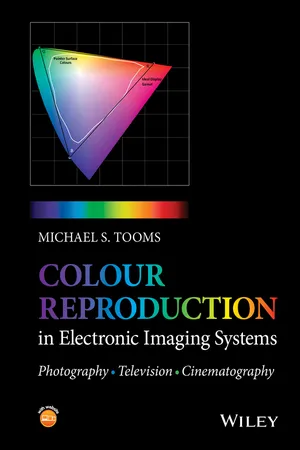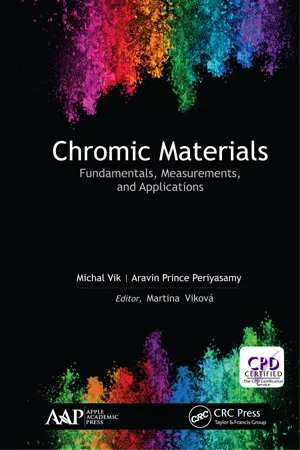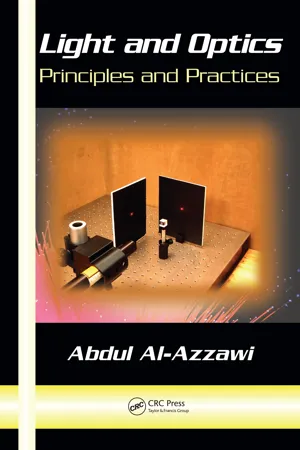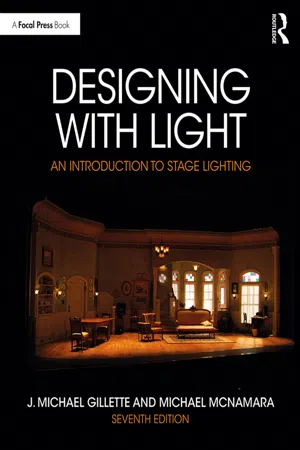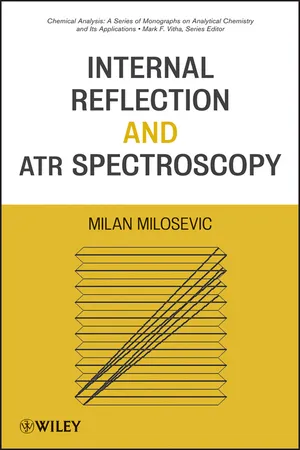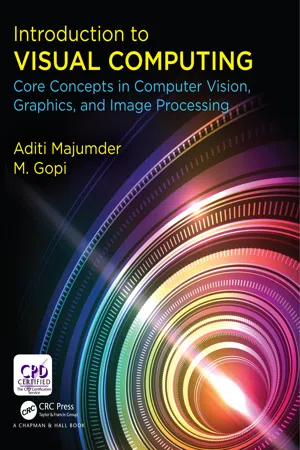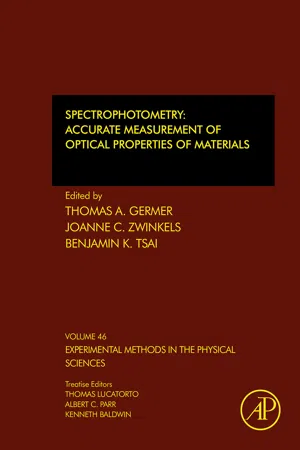Physics
Spectral Colour
Spectral color refers to the specific colors that make up the visible light spectrum, which includes red, orange, yellow, green, blue, indigo, and violet. Each of these colors corresponds to a specific wavelength of light. When combined, these spectral colors create white light. Spectral colors are fundamental to understanding the behavior of light and its interaction with matter.
Written by Perlego with AI-assistance
Related key terms
10 Key excerpts on "Spectral Colour"
- eBook - ePub
Colour Reproduction in Electronic Imaging Systems
Photography, Television, Cinematography
- Michael S. Tooms(Author)
- 2015(Publication Date)
- Wiley(Publisher)
We are now getting into the detail of what colours we see when certain parts of the spectrum are missing. We know that when the eye is exposed to a spectrum comprising broadly equal amounts of light from violet to red, we perceive the colour white; but in order to be able to predict what we see when a combination of elements of the spectrum are present, we need to investigate how the eye–brain complex responds to mixtures of elements of the spectrum. To do this we need to characterise in some detail how the eye responds to light of differing levels and to light of various frequencies or wavelengths within the spectrum.1.3 Characterising the Responses of the Eye to Light
Colour is the term we use to describe how the eye perceives light of varying strength at different wavelengths, and light may be defined as the energy in that segment of the electromagnetic spectrum to which the eye responds. The electromagnetic spectrum in its entirety is extremely broad and comprises with increasing frequency: radio, infrared, light, ultraviolet, x-rays and gamma rays. In many branches of science and engineering electromagnetic energy is discussed in terms of frequency whilst in others it is in terms of wavelength. Wavelength and frequency of light are inversely related by the speed of light such that the wavelength ‘λ’ (lambda) equals the speed of light ‘c’ divided by the frequency ‘f’ in cycles per second.2where c = 2.99792458 × 108 m/s or very nearly 3 × 108 m/s.In treating the subject of light and colour the general practice is to refer to light of a given wavelength rather than to its frequency and to a band of wavelengths as a spectrum.The eye perceives colour as a characteristic of light. Light is formally that very narrow segment of the electromagnetic energy spectrum occupying wavelengths of approximately 380–720 nm. (A nanometre or nm is one thousand millionth of a metre or 10−9 - eBook - ePub
Principles of Colour and Appearance Measurement
Object Appearance, Colour Perception and Instrumental Measurement
- Asim Kumar Roy Choudhury(Author)
- 2014(Publication Date)
- Woodhead Publishing(Publisher)
Equation [2.17] :[2.17]where P λ is the spectral concentration of the radiant power reflected by the medium and P 0λ is the spectral concentration of radiant power incident on the medium.Absolute reflectance is less reliable to measure. Hence, the International Commission on Illumination (CIE), Paris, has defined another term, spectral reflectance factor R λ , as the ratio of the light flux reflected from the sample to the light flux reflected from a perfect isotropic reflecting diffuser identically illuminated and viewed by the instrument at wavelength λ. The reflectance values are independent of the energy distribution of the illuminant as long as the material is not fluorescent.When a light beam is incident on a dyed or pigmented specimen, the radiant energy interacts with colourant particles as well as molecules of the medium carrying those particles, resulting in absorption and scattering of light. In the absorption process, the light energy is absorbed by the colourant and converted to heat and other forms of energy. In the scattering process, the direction of the light beam is altered.The relation between absorption and scattering is very important in colour science to predict the quantities of colourants required to produce a particular colour. Various mathematical models, such as those of Kubelka and Munk (1931) , are in use to solve the problems of multiple scattering in dyed textiles, paint, etc.2.7 Mechanisms of colour generation
Around us, in our homes, at work, in nature and in space, everyone has a colour of some sort. But have you ever thought about what makes something colourful? Why is ruby red red, while emerald is green? The simple answer is that when white light passes through a ruby, it emerges with a higher proportion of longer wavelength, which the eye recognises as red. Light passing through an emerald releases light of a different distribution of wavelengths, which is perceived as green. This explanation is correct, but incomplete. How does matter alter the composition of light it reflects or transmits? - eBook - ePub
Chromic Materials
Fundamentals, Measurements, and Applications
- Michal Vik, Aravin Prince Periyasamy, Martina Viková, Martina Viková(Authors)
- 2018(Publication Date)
- Apple Academic Press(Publisher)
Figure 1.2 ).Similarly, in other cases like the electromagnetic spectrum, it is impossible to define exact borders. The entire range of wavelength is divided in Table 1.1 , which represents spectral colors and approximate wavelength intervals associated with them.1.2 Blackbody RadiationThe temperature of a blackbody radiator can be used as a means to quantify the energy distribution of an illuminant. If a metallic object is heated, after a short time, it becomes too hot to touch. This is due to emission of infrared radiation. With more heating, the object begins to glow; first, a dull red color appears, followed by bright red, yellow, white, and even blue at higher temperatures. Blackbody radiation or cavity radiation refers to an object or system that absorbs all radiation incident upon it and re-radiates energy; this characteristic of the radiating system does not dependent upon the type of radiation which is incident upon it. The radiated energy can be considered to be produced by a standing wave or resonant modes of the cavity, which is radiating (Figure 1.3 ).FIGURE 1.2 The electromagnetic spectrum.Classical description of blackbody radiation is based on Rayleigh-Jeans law:TABLE 1.1 Color of Absorbed Light and Corresponding Complementary Colors(1.4)E=v0k T2 πv 2c 2where k = 1.380662×10−23 J.K−1 is Boltzmann constant, and T is thermodynamic temperature in kelvins (K).FIGURE 1.3 - eBook - ePub
- John H Xin(Author)
- 2006(Publication Date)
- Woodhead Publishing(Publisher)
Part I Measuring colourPassage contains an image
1Colour perception
S. Westland; V. Cheung University of Leeds, UK1.1 Introduction
Colour exists only in the mind; it is a perceptual response to light that enters the eye either directly from self-luminous light sources or, indirectly, from light reflected by illuminated objects. The nature of light and the spectral reflectance properties of objects are therefore described in the first part of this chapter. The second part of the chapter is concerned with the physiology and functional properties of the retina in the human eye. Light that enters the eye is sampled by three classes of light-sensitive cells in the retina known as cones. In order to understand colour, it is necessary to appreciate that the effective spectral sensitivities of these cones are not static; rather, they change with the illumination conditions and the responses of spatially neighbouring cells, to name but two factors. Furthermore, the three classes of signals from the cones are processed by the neural pathways that lead from the retina to various areas of the cortex in the brain. Although our understanding of colour processing in the human visual system is sufficient to allow us to predict when two spectrally dissimilar objects will be a visual match, it does not allow us to make reliable predictions of colour appearance. In this chapter, three current problems for the science of colour vision are described: colour contrast, colour constancy and colour appearance.1.2 The nature of colour
Light is a form of energy. Specifically, it is that part of the spectrum of electromagnetic radiation that our eyes are sensitive to. Radio waves and X-rays, as well as ultraviolet and infrared radiation, are all part of the spectrum of electromagnetic radiation but the human visual system is only capable of sensing a very narrow band of wavelengths in the approximate range 360–780 nm (a nanometer is 10− 9 metres). The light from any source can be usefully described in terms of the relative power emitted at each wavelength in the visible spectrum. Figure 1.1 - eBook - ePub
Light and Optics
Principles and Practices
- Abdul Al-Azzawi(Author)
- 2018(Publication Date)
- CRC Press(Publisher)
Equation (6.1) :
6.8 COLOUR TEMPERATURESpectral Transmittance =Transmitted PowerIncident Power(6.1) Colour temperature is a method of specifying the colour of a light source, but it should only be used when the source emits a continuous spectrum if it is to indicate the colour-rendering properties of the source. The colour temperature is measured in absolute temperature in Kelvin (K). Figure 6.13 shows some examples of colour temperature.Although white light contains all the colours of the spectrum, they need not be present with the same intensity. For example, sunlight, often used as a reference standard for white light, does not have the same intensity at all wavelengths. The intensity of sunlight reaching the earth’s surface peaks near a wavelength of 474 nm and falls off sharply in the ultraviolet. A comparison of the solar data with the Planck theory of blackbody radiation can be used to determine the sun’s temperature, giving a result of about 6000 K. Incandescent lamps are good approximations of blackbody radiations and give off white light; however, this light is deficient in the blue and violet. The spectrum is skewed toward the red because of the relatively low operating temperature of incandescent lamps, about 2900 K. The spectrum distribution of the light is described in terms of the corresponding temperature of a blackbody, termed the colour temperature. At a colour temperature of 2900 K, only 3% of the energy dissipated in the lamp emerges as visible light. Special high-temperature lamps designed for photography and television usually operate at one of two reference temperatures, 3000 or 3400 K. They produce considerably more blue than ordinary household lamps. Table 6.1 - eBook - ePub
- Grant R. Fowles(Author)
- 2012(Publication Date)
- Dover Publications(Publisher)
CHAPTER 8Optical Spectra
8.1 General Remarks
A spectrum may be defined as an ordering of electromagnetic radiation according to frequency, or what amounts to the same thing, an ordering by wavelength. The complete spectrum of a given source comprises all the frequencies that the source emits. Since no single universal frequency-resolving instrument exists, the various regions of the electromagnetic spectrum must be investigated by different methods. The main regions have already been mentioned in Section 1.4.The so-called “optical” region extends over a wide range from the far infrared on the one end to the far ultraviolet on the other. It includes the visible region as a relatively small portion (Figure 8.1 ).Figure 8.1 . The optical region of the electromagnetic spectrum.In practice the optical region is characterized by (1) the fact that the radiation is focused, directed, and controlled by mirrors and lenses, and (2) the use of prisms and gratings for dispersing the radiation into a spectrum.Unlike the continuous spectrum of thermal radiation given off by solid bodies, the radiation emitted by excited atoms or molecules is found to consist of various discrete frequencies. These frequencies are characteristic of the particular kinds of atoms or molecules involved. The term “line” spectrum is commonly used when referring to such radiation. This terminology originates from the fact that a slit is generally the type of entrance aperture for spectroscopic instruments used in the optical region, so a separate line image of the slit is formed at the focal plane for each different wavelength comprising the radiation. Sources of line spectra include such things as arcs, sparks, and electric discharges through gases.The optical spectra of most atoms are quite complex and the line patterns are seemingly random in appearance. A few elements, notably hydrogen and the alkali metals, exhibit relatively simple spectra that are characterized by easily recognized series - eBook - ePub
Designing with Light
An Introduction to Stage Lighting
- J. Michael Gillette, Michael McNamara(Authors)
- 2019(Publication Date)
- Routledge(Publisher)
ColorColor is easily the most noticeable of the elements that a lighting designer can control and, arguably, the most dominant. It is also the least understood. We grow up with color all around us, and we see and use it every day. It is probably because of our constant contact with color that we accept it without really thinking about it. This chapter attempts to help you understand the complex subject of color.Defining Color
Color has a variety of definitions. It can be defined as a perception created in the brain that results from stimulation of the retina by light waves of a certain length. It can also be thought of as the intrinsic physical properties of specific objects that allow those objects to reflect and absorb light waves of a certain length.The common denominator for any definition of color is light, because all color is derived from light. The phenomenon that we call light is actually the very narrow portion of the spectrum of electromagnetic radiation that is visible to the human eye. Figure 8.1 shows the position of visible light on this spectrum, as well as the positions of some of the other types of radiation. The visible spectrum stretches in frequency from approximately 400 to 750 nanometers. (A nanometer is one-billionth of a meter.) Figure 8.2 shows the approximate wavelengths for the various colors of the visible spectrum.Color Terminology
paint chipA small rectangle of paper or thin cardboard painted in a specific hue.Without a specific set of terms to describe the various properties of color, almost any discussion of color would quickly degenerate into meaningless comparisons. An example will help explain this reality. If you provided each member of a group of 20 people with 100paint chips - eBook - ePub
- Milan Milosevic(Author)
- 2012(Publication Date)
- Wiley(Publisher)
1 Introduction to Spectroscopy1.1 HISTORY
Spectroscopy got its start with Newton’s observation that the white light from the sun can be separated into different colors using a prism. This observation became not only foundational to the theory of light but also to the understanding of human color vision. Color vision is a crude form of spectroscopy. We can often guess on the nature of a material by its color. We can only perceive three primary colors. That makes the human eye a very crude spectrometer. However, even at this crude level, it was apparently advantageous to us, during evolutionary history, to trade higher image resolution for color vision.In the times of Newton, the hurdle to overcome was to understand the nature of light. Newton himself proposed the so-called corpuscular theory of light with which he was able to explain all then known properties of light (i.e., the propagation of light in a straight line and the laws of reflection and refraction). Newton proposed that light consists of tiny particles (corpuscles). Huygens, a contemporary of Newton, proposed the so-called wave theory of light, in which light is a wave phenomenon like a wave on the surface of water. Using his theory, he too was able to explain all the known properties of light. To make their respective theories work, Newton and Huygens made opposite assumptions about the speed of light in optically transparent media such as water or glass. Newton needed light to go faster through such media for his theory to work. Huygens needed it to go slower.However, what settled the dispute was not the measurement of the speed of light in transparent media; it was the observation that light can form interference patterns. Only waves can form interference patterns and that settled the dispute. Huygens won. Later, measurements of the speed of light in denser media such as water confirmed Huygens’s assumption. Light was a wave phenomenon.Different colors of light correspond to different wavelengths. In studying light dispersion by a glass prism, Herschel noticed that there is an invisible component of solar radiation next to red light. Thus, infrared (IR) light was discovered. Later, it was discovered that there is also an invisible component of solar radiation next to violet that was named ultraviolet (UV). - eBook - ePub
Introduction to Visual Computing
Core Concepts in Computer Vision, Graphics, and Image Processing
- Aditi Majumder, M. Gopi(Authors)
- 2018(Publication Date)
- CRC Press(Publisher)
For every radiometric property, there is a corresponding photometric property that intuitively measures “how much of it can the human observer make use of’. Therefore, photometric quantities have an aspect of perception associated with them. Color is a photometric quantity that we use all the time. It is a part and parcel of our lives, so much so, that we probably cannot appreciate it unless we lose our perception of color. Mr. I, who lost color perception due to an accident exclaimed with anguish, “My dog looks gray, tomato juice is black and color TV is an hodge podge”. Color not only adds beauty to our life, but serves important signaling functions. The natural world provide us with many signals to identify and classify objects. Many of these come in terms of color. For e.g. banana turns yellow when its ripe, the sky turns red when it is dawn and so on.Figure 9.2 . This figure shows the visible spectrum of light and its position with respect to the invisible spectrum.The color stimuli is the radiometric quantity (usually radiance), that reaches the human eye from any point in the world. The important parameter in the context of photometry, and therefore color vision, is the associated wavelength. The visible light spectrum has wavelength that varies between 400 nm and 700 nm . Figure 9.2 shows the visible spectrum of colors. A illumination or an object selectively emit or reflect respectively certain wavelengths more than other. Two things are responsible for our color vision and hence photometry. The first is the selective reflection of wavelengths by different objects. However, it is only one of the factors responsible for the color of an object. The second important factor is the eye’s selective response to different wavelengths. This response, and hence the perception of color, can be different from species to species, and also shows a variance across individuals of the same species. That is the reason, color is often considered as a perception, and not reality!λLet us start from the illumination of a scene. A scene is usually lighted by some light source. This light source emits light differently at different wavelengths. This function, denoted byλgives the illumination spectrum. Similarly, for an object, its relative reflectance at different wavelengths define its reflectance spectrumI ( λ ). Since the reflectance or reflectivity of an object is the ratio of outgoing to incoming power, it is between 0 and 1 for an object that is not a light source. These spectra for a couple of light sources and a red apple are illustrated in Figure 9.3R ( λ ) - eBook - ePub
Spectrophotometry
Accurate Measurement of Optical Properties of Materials
- (Author)
- 2014(Publication Date)
- Academic Press(Publisher)
[3] . The geometric attributes are based on the directional distribution of reflected or transmitted light, described by attributes like specular gloss, haze, orange peel, and so on. Color and gloss are the attributes most often use to characterize the appearance of objects.10.2 Spectral Attributes—Color
10.2.1 Definition
Ultimately, the goal of color measurement is to model the perception of a human observer. The human visual system (HVS) has three overlapping broadband detectors: short (S)-, medium (M)-, and long (L)-wavelength cones. The average spectral sensitivities of these are shown in Fig. 10.1 . In principle, an instrument that accurately quantifies the behavior of these three detectors should be able to predict color perception. Even with such a high spectral bandwidth, a three-channel system can do a very good job of color measurement. The limits of such a system will be shown below in the discussion on the relationship among the light source, the object, and the human observer.Figure 10.1 The average spectral sensitivity of the human visual system.To understand color measurement, we must explore the system under which a human observer experiences color. For color perception of an object to exist, there need to be three components: a light source, an object, and a human observer. Figure 10.2 shows the relationship between these components. Light from the source is incident on the object (arrow 1), and some of that light reflects off the object (arrow 2). Thus, the observer sees the original light after modification by the object. The third arrow indicates that the source also has a direct effect on the human observer, and hence the color perception. The perception cannot be described simply as the physical relationship between the spectral properties of the source and the object. Human observers adapt to the source, and color can be greatly affected by this adaptation. Adaptation—a physiological response—must be accounted for to properly estimate color from instrumental data. As will be explored in Section 10.2.2
Index pages curate the most relevant extracts from our library of academic textbooks. They’ve been created using an in-house natural language model (NLM), each adding context and meaning to key research topics.
